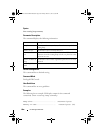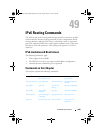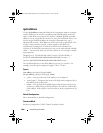
1090 IPv6 Routing Commands
ipv6 address
Use the ipv6 address command in Interface Configuration mode to configure
an IPv6 address on an interface (including tunnel and loopback interfaces)
and to enable IPv6 processing on this interface. Multiple globally reachable
addresses can be assigned to an interface by using this command. There is no
need to assign a link-local address by using this command since one is
automatically created. IPv6 addresses can be expressed in eight blocks. Also
of note is that instead of a period, a colon separates each block. For
simplification, leading zeros of each 16-bit block can be omitted. One
sequence of 16-bit blocks containing only zeros can be replaced with a double
colon “::”, but not more than one at a time (otherwise it is no longer a unique
representation).
Dropping zeros: 3ffe:ffff:100:f101:0:0:0:1 becomes 3ffe:ffff:100:f101::1
Local host: 0000:0000:0000:0000:0000:0000:0000:0001 becomes ::1
Any host: 0000:0000:0000:0000:0000:0000:0000:0000 becomes ::
The hexadecimal letters in the IPv6 addresses are not case-sensitive. An
example of an IPv6 prefix and prefix length is 3ffe:1::1234/64.
Syntax
ipv6 address
prefix/prefix-length
[eui64]
no ipv6 address [
prefix/prefix-length
]
[eui64]
•
prefix
— Consists of the bits of the address to be configured.
•
prefix-length
— Designates how many of the high-order contiguous bits of
the address make up the prefix.
•
eui64
— The optional eui-64 field designates that IPv6 processing on the
interfaces is enabled using an EUI-64 interface ID in the low order 64 bits
of the address. If this option is used, the value of
prefix_length
must be 64
bits.
Default Configuration
This command has no default configuration.
Command Mode
Interface Configuration (VLAN, Tunnel, Loopback) mode.
2CSPC4.X8100-SWUM102.book Page 1090 Friday, March 15, 2013 8:56 AM


















